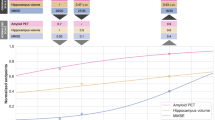Abstract
In this study, we employ a transformer encoder model to characterize the significance of longitudinal patient data for forecasting the progression of Alzheimer’s Disease (AD). Our model, Longitudinal Forecasting Model for Alzheimer’s Disease (LongForMAD), harnesses the comprehensive temporal information embedded in sequences of patient visits that incorporate multimodal data, providing a deeper understanding of disease progression than can be drawn from single-visit data alone. We present an empirical analysis across two patient groups—Cognitively Normal (CN) and Mild Cognitive Impairment (MCI)—over a span of five follow-up years. Our findings reveal that models incorporating more extended patient histories can outperform those relying solely on present information, suggesting a deeper historical context is critical in enhancing predictive accuracy for future AD progression. Our results support the incorporation of longitudinal data in clinical settings to enhance the early detection and monitoring of AD. Our code is available at https://github.com/batuhankmkaraman/LongForMAD.
Access this chapter
Tax calculation will be finalised at checkout
Purchases are for personal use only
Similar content being viewed by others
References
Altay, F., Sanchez, G.R., James, Y., Faraone, S.V., Velipasalar, S., Salekin, A.: Preclinical stage Alzheimer’s disease detection using magnetic resonance image scans. arXiv (Cornell University), November 2020. https://doi.org/10.48550/arxiv.2011.14139
Campos, S., Pizarro, L., Valle, C., Gray, K.R., Rueckert, D., Allende, H.: Evaluating imputation techniques for missing data in ADNI: a patient classification study. In: Pardo, A., Kittler, J. (eds.) CIARP 2015. LNCS, vol. 9423, pp. 3–10. Springer, Cham (2015). https://doi.org/10.1007/978-3-319-25751-8_1
Chen, Q., Hong, Y.: LongFormer: longitudinal transformer for Alzheimer’s disease classification with structural MRIs, December 2023. https://doi.org/10.48550/arXiv.2302.00901, https://arxiv.org/abs/2302.00901
Chen, Y., et al.: Progression from normal cognition to mild cognitive impairment in a diverse clinic-based and community-based elderly cohort. Alzheimer’s Dement. 13, 399–405 (2017). https://doi.org/10.1016/j.jalz.2016.07.151
Cui, R., Liu, M.: RNN-based longitudinal analysis for diagnosis of Alzheimer’s disease. Comput. Med. Imaging Graph. 73, 1–10 (2019). https://doi.org/10.1016/j.compmedimag.2019.01.005
Fischl, B., et al.: Automatically parcellating the human cerebral cortex. Cerebral Cortex 14(1), 11–22 (2004). https://doi.org/10.1093/cercor/bhg087, http://cercor.oxfordjournals.org/content/14/1/11.abstract
Fouladvand, S., Noshad, M., Periyakoil, V.J., Chen, J.H.: Machine learning prediction of mild cognitive impairment and its progression to Alzheimer’s disease. Health Sci. Rep. 6, e1438 (2023). https://doi.org/10.1002/hsr2.1438
Hu, Z., Wang, Z., Jin, Y., Hou, W.: VGG-TSwinformer: transformer-based deep learning model for early Alzheimer’s disease prediction. Comput. Methods Programs Biomed. 229, 107291 (2023). https://doi.org/10.1016/j.cmpb.2022.107291
Jack, C.R., et al.: Magnetic resonance imaging in Alzheimer’s disease neuroimaging initiative 2. Alzheimer’s Dement. 11, 740–756 (2015). https://doi.org/10.1016/j.jalz.2015.05.002, https://www.sciencedirect.com/science/article/pii/S1552526015001685
Jarrett, D., Yoon, J., van der Schaar, M.: Dynamic prediction in clinical survival analysis using temporal convolutional networks. IEEE J. Biomed. Health Inform. 24, 424–436 (2020). https://doi.org/10.1109/jbhi.2019.2929264
Karaman, B.K., Mormino, E.C., Sabuncu, M.R.: Machine learning based multi-modal prediction of future decline toward Alzheimer’s disease: an empirical study. PLOS ONE 17, e0277322 (2022). https://doi.org/10.1371/journal.pone.0277322
Kingma, D., Lei Ba, J.: Adam: a method for stochastic optimization, January 2017. https://arxiv.org/pdf/1412.6980.pdf
Lee, H., Kim, J., Park, E., Kim, M., Kim, T., Kooi, T.: Enhancing breast cancer risk prediction by incorporating prior images. In: Greenspan, H., et al. (eds.) Medical Image Computing and Computer Assisted Intervention – MICCAI 2023. MICCAI 2023. LNCS, vol. 14224, pp. 389–398. Springer, Cham (2023). https://doi.org/10.1007/978-3-031-43904-9_38
Li, F., Liu, M.: A hybrid convolutional and recurrent neural network for hippocampus analysis in Alzheimer’s disease. J. Neurosci. Methods 323, 108–118 (2019). https://doi.org/10.1016/j.jneumeth.2019.05.006
Li, Y., et al.: Discriminant analysis of longitudinal cortical thickness changes in Alzheimer’s disease using dynamic and network features. Neurobiol. Aging 33, 427.e15–427.e30 (2012). https://doi.org/10.1016/j.neurobiolaging.2010.11.008
Li, Y., et al.: BEHRT: transformer for electronic health records. Sci. Rep. 10, 7155 (2020). https://doi.org/10.1038/s41598-020-62922-y
ADNI|study documents. https://adni.loni.usc.edu/methods/documents/
Mueller, S.G., et al.: Ways toward an early diagnosis in Alzheimer’s disease: the Alzheimer’s disease neuroimaging initiative (ADNI). Alzheimer’s Dement. 1, 55–66 (2005). https://doi.org/10.1016/j.jalz.2005.06.003
Shen, Y., et al.: Leveraging transformers to improve breast cancer classification and risk assessment with multi-modal and longitudinal data, November 2023. https://arxiv.org/pdf/2311.03217.pdf
Vaswani, A., et al.: Attention is all you need, June 2017. https://arxiv.org/abs/1706.03762
Wang, X., et al.: Predicting up to 10 year breast cancer risk using longitudinal mammographic screening history. medRxiv (2023). https://doi.org/10.1101/2023.06.28.23291994, https://www.medrxiv.org/content/early/2023/06/29/2023.06.28.23291994
Yuan, W., et al.: Temporal bias in case-control design: preventing reliable predictions of the future. Nat. Commun. 12, 1107 (2021). https://doi.org/10.1038/s41467-021-21390-2
Zhang, D., Shen, D.: Predicting future clinical changes of MCI patients using longitudinal and multimodal biomarkers. PLoS ONE 7, e33182 (2012). https://doi.org/10.1371/journal.pone.0033182
Acknowledgments
Data used in preparation of this article were obtained from the Alzheimer’s Disease Neuroimaging Initiative (ADNI) database (adni.loni.usc.edu). As such, the investigators within the ADNI contributed to the design and implementation of ADNI and/or provided data but did not participate in analysis or writing of this report. A complete listing of ADNI investigators can be found at: http://adni.loni.usc.edu/wp-content/uploads/how_to_apply/ADNI_Acknowledgement_List.pdf This project was also funded by NIH R01AG053949, and NSF CAREER 1748377 grants.
Author information
Authors and Affiliations
Corresponding author
Editor information
Editors and Affiliations
Ethics declarations
Disclosure of Interests
The authors have no relevant competing interests.
1 Electronic supplementary material
Below is the link to the electronic supplementary material.
Rights and permissions
Copyright information
© 2024 The Author(s), under exclusive license to Springer Nature Switzerland AG
About this paper
Cite this paper
Karaman, B.K., Sabuncu, M.R. (2024). Assessing the Significance of Longitudinal Data in Alzheimer’s Disease Forecasting. In: Xie, X., Styles, I., Powathil, G., Ceccarelli, M. (eds) Artificial Intelligence in Healthcare. AIiH 2024. Lecture Notes in Computer Science, vol 14975. Springer, Cham. https://doi.org/10.1007/978-3-031-67278-1_1
Download citation
DOI: https://doi.org/10.1007/978-3-031-67278-1_1
Published:
Publisher Name: Springer, Cham
Print ISBN: 978-3-031-67277-4
Online ISBN: 978-3-031-67278-1
eBook Packages: Computer ScienceComputer Science (R0)




